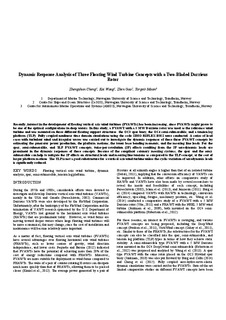Dynamic Response Analysis of Three Floating Wind Turbine Concepts with a Two-Bladed Darrieus Rotor
Journal article, Peer reviewed
Permanent lenke
http://hdl.handle.net/11250/2391312Utgivelsesdato
2015Metadata
Vis full innførselSamlinger
- Institutt for marin teknikk [3432]
- Publikasjoner fra CRIStin - NTNU [38127]
Sammendrag
Recently, interest in the development of floating vertical axis wind turbines (FVAWTs) has been increasing, since FVAWTs
might prove to be one of the optimal configurations in deep waters. In this study, a FVAWT with a 5 MW Darrieus rotor
was used as the reference wind turbine and was mounted on three different floating support structures: the OC3 spar buoy,
the OC4 semi-submersible, and a tension leg platform (TLP). Fully coupled nonlinear time domain simulations using the
code SIMO-RIFLEX-DMS were conducted. A series of load cases with turbulent wind and irregular waves was carried out
to investigate the dynamic responses of these three FVAWT concepts by estimating the generator power production, the
platform motions, the tower base bending moments, and the mooring line loads. For the spar, semi-submersible, and TLP
FVAWT concepts, twice-per-revolution (2P) effects resulting from the 2P aerodynamic loads are prominent in the dynamic
responses of these concepts. Because of the compliant catenary mooring systems, the spar and the semi-submersible can
help to mitigate the 2P effects on structural loads and mooring line tensions as compared to the TLP concept, at the cost of
larger platform motions. The TLP is not a good substructure for a vertical axis wind turbine unless the cyclic variation of
aerodynamic loads is significantly reduced.
